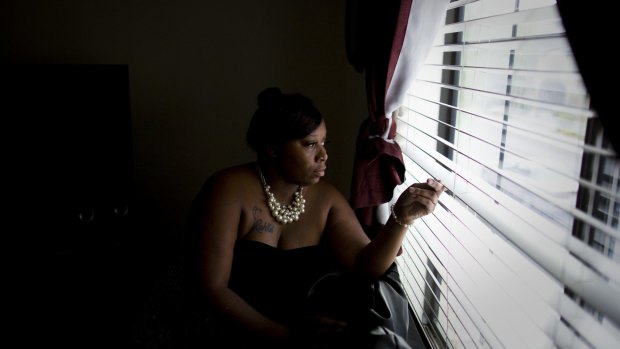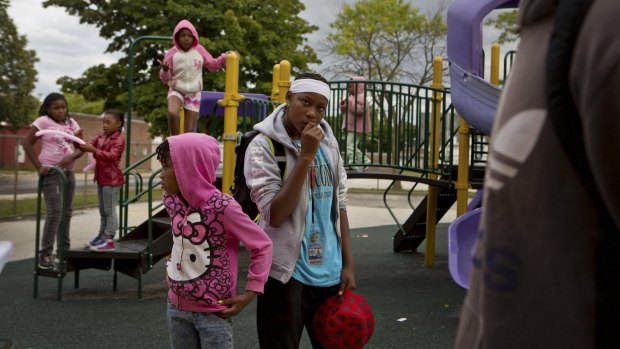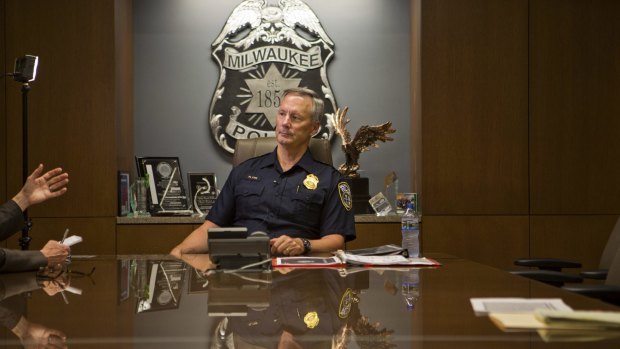This was published 8 years ago
Guns, gangs, 'Ferguson effect' cited as murder rates rise sharply in US cities
By Monica Davey
Milwaukee: Cities across the nation are seeing a startling rise in murders after years of declines, and few places have witnessed a shift as precipitous as this city. With the summer not yet over, 104 people have been killed this year – after 86 homicides in the whole of 2014.
More than 30 other cities have also reported increases in violence from a year ago. In New Orleans, 120 people had been killed by late August, compared with 98 during the same period a year earlier. In Baltimore, homicides have hit 215, up from 138 at the same point in 2014. In Washington, the toll is 105, compared with 73 people a year ago. And in St Louis, 136 people have been killed this year, a 60 per cent rise from the 85 murders the city had by the same time last year.

Tamiko Holmes, a mother of five who lost two of her children in separate shootings in Milwaukee, before finally leaving the city with her remaining children.Credit: New York Times
Law enforcement experts say disparate factors are at play in different cities, though no one is claiming to know for sure why murder rates are climbing. Some officials say intense national scrutiny of the use of force by the police has made officers less aggressive and emboldened criminals, though many experts dispute that theory.
Rivalries among organised street gangs, often over drug turf, and the availability of guns are cited as major factors in some cities, including Chicago. But more commonly, many top police officials say they are seeing a growing willingness among disenchanted young men in poor neighbourhoods to use violence to settle ordinary disputes.

Essence Gilchrist, 15, centre, with Amiya Singleton, 7, on an elementary school playground in the north side of Milwaukee, a city that has had a steep rise in murders this year.Credit: New York Times
"Maintaining one's status and credibility and honour, if you will, within that peer community is literally a matter of life and death," said Milwaukee's police chief, Edward Flynn. "And that's coupled with a very harsh reality, which is the mental calculation of those who live in that strata that it is more dangerous to get caught without their gun than to get caught with their gun."
The results have often been devastating. Tamiko Holmes, a mother of five, has lost two of her nearly grown children in apparently unrelated shootings in the past eight months. In January, a daughter, 20, was shot to death during a robbery at a birthday party at a Days Inn. Six months later, the authorities called again: her only son, 19, had been shot in the head in a car – a killing for which the police are still searching for a motive and a suspect.
Ms Holmes said she recently persuaded her remaining teenage daughters to move away from Milwaukee with her, but not before one of them, 17, was wounded in a shooting while riding in a car.
"The violence was nothing like this before," said Ms Holmes, 38, who grew up in Milwaukee. "What's changed is the streets and the laws and the parents. It's become a mess and a struggle."

Milwaukee police chief Edward Flynn: trying to cope with a precipitous rise the murder rate this year.Credit: New York Times
Urban bloodshed – as well as the overall violent crime rate – remains far below the peaks of the late 1980s and early '90s, and criminologists say it is too early to draw broad conclusions from the recent numbers.
With at least 35 of the nation's cities reporting increases in murders, violent crimes or both, according to a recent survey, the spikes are raising alarm among urban police chiefs. The uptick prompted an urgent summit meeting in August of more than 70 officials from some of the nation's largest cities. A Justice Department initiative is scheduled to address the rising homicide rates as part of a conference in September.
In New York, killings have increased about 9 per cent, to 208 through mid-August from 190 a year earlier. Homicides in Chicago are up about 20 per cent over the same period a year ago.
The police superintendent in Chicago, Garry McCarthy, said he thought an abundance of guns was a major factor in his city's homicide spike. Even as officials in both parties are calling for reducing the prison population, he insisted that gun offenders should face stiffer penalties.
Among some experts and rank-and-file officers, the notion that less aggressive policing has emboldened criminals – known as the "Ferguson effect" in some circles – is a popular theory for the uptick in violence. "The equilibrium has changed between police and offenders," said Alfred Blumstein, a professor and a criminologist at Heinz College, Carnegie Mellon University.
Others doubt the theory or say data has not emerged to prove it. Richard Rosenfeld, a criminologist from the University of Missouri-St. Louis, said homicides in St. Louis, for instance, had begun an arc upward in 2014 before a white police officer killed an unarmed teenager, Michael Brown, in nearby Ferguson. That data, he said, suggests that other factors may be in play.
Less debated is the sense among police officials that more young people are settling their disputes, including one started on Facebook, with guns.
Captain Mike Sack, a homicide commander in the St Louis Metropolitan Police Department, cited killings there that had grown out of arguments over girlfriends, food and even characters on a TV show. "Most remarkable is that individuals get so upset over things that I or others might consider petty but resort to such a level of violence," he said.
Mayor Tom Barrett of Milwaukee, who is up for re-election early next year, receives text messages about every homicide; they come faster now, every few days. The issue is taking centre stage in the race: some of Mr Barrett's critics say he is not doing enough to stop crime, while citing what they consider low investment in the city's African-American neighbourhoods and mistreatment of black residents by the police.
"I have to find a way for these young kids to understand that they have a stake in society," said Mr Barrett, who has met with pastors, community leaders and others to discuss the killings.
New York Times